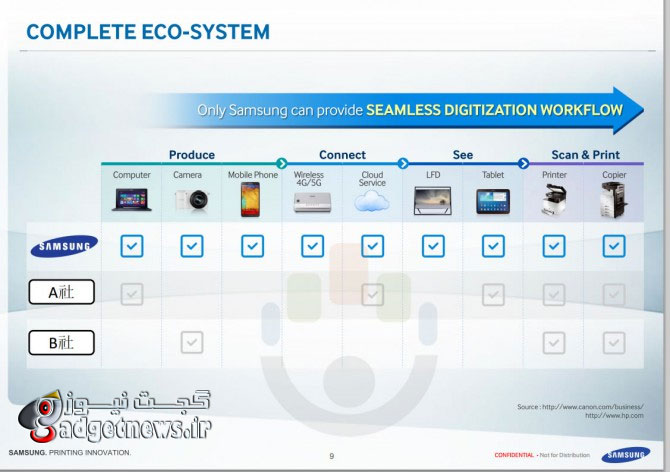
گويا سامسونگ از تاخت و تاز در بازار خسته نشده و نقشه هايي براي بازار ساير محصولات در سر دارد ، سامسونگ میخواهد تا سال 2020 به یکهتاز بازارهای چاپگر دنیا تبدیل شود. آیا این شرکت خیالاتی شده یا واقعا برنامهای مدون برای رسیدن به این هدف دارد. در ادامه با اخبار تکميلي با گجت نيوز همراه باشيد .
در حال حاضر سامسونگ در رتبه پنجم بزرگترین تأمینکنندگان پرینتر دنیا بعد از اچپی، کانن، اپسون و برازر قرار دارد. اما سامسونگ نقشههایی جدید در سر میپروراند. نقشه این است که این شرکت چنان رشد سریعی داشته باشد که تا 2020 به بزرگترین تأمینکننده پرینتر دنیا تبدیل شود!

یکی از مسئولین سامسونگ اعتقاد دارد به دلیل اینکه این شرکت قادر است یکپارچهترین سیستم دیجیتالسازی را ایجاد کند، پس رسیدن به این هدف ممکن است. چنین سیستم یکپارچهای به این معنی است که کاربران میتوانند محتوا تولید کنند، آن را به انواع دستگاههای ساخت این شرکت بفرستند، در تلویزیون یا تبلتهای سامسونگ آنها را ببینند و در نهایت اگر خواستند آن را چاپ کنند. سامسونگ در حال حاضر توانسته تنها 5 درصد از بازار چاپگرها را از آن خود کند و این در حالی است که اچپی با 40 درصد سهم بازار یکهتازی میکند. رسیدن از 5 به 40 درصد تلاشی بینهایت و خوششانسی بزرگی برای این شرکت میطلبد.سامسونگ قطعا در این بازار کار راحتتری نسبت به بازارهای تلویزیون، پیسی و دیگر لوازم الکترونیکی دارد و میتواند حداقل از این لحاظ امید بیشتری برای رسیدن به هدفش داشته باشد.
منبع : myce
After Samsung conquered the memory chip, TV and smartphone market, the company now aims for the printer market share. A confidential Samsung document leaked to Myce shows how the company aims to become the number 1 printer manufacturer by 2020.
The printing market is valued at $724 billion for 2014. Currently Samsung is the fifth largest printer manufacturer after HP, Canon, Epson and Brother. HP dominates the market with a global market share of nearly 40%, where Samsung has a global market share of 5% outlining how much the company can grow in the market.
The company already dominates the smart TV and smartphone market in which it reached the number one position in only a couple of years.
The company states it’s the only company that can provide a seamless digitization workflow. In the documents it compares itself to two competitors (Canon and HP) and shows it has a product line where users can produce content, send the content to devices, view the content on e.g. a TV or tablet and finally can to scan or print the content.
Although the benefits of a seamless workflow is obvious for consumers, the disadvantage could be that Samsung will use proprietary protocols which makes their equipment inoperable with devices of other manufacturers.
 گجت نیوز آخرین اخبار تکنولوژی، علم و خودرو
گجت نیوز آخرین اخبار تکنولوژی، علم و خودرو 





